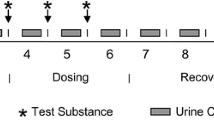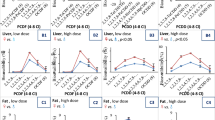Abstract
Specimens of the feral mouse species Reithrodontomys fulvescens trapped from a polychlorinated biphenyl (PCB)-contaminated field location had hepatic ethoxy-resorufin (ETR) O-dealkylase activities and immunoreactive CYP1A protein contents which were two- to threefold higher than those measured in animals of the same species and sex collected from non PCB-contaminated reference sites. Specimens with hepatic ETR O-dealkylase activities differing by as little as 50% could readily be assigned as originating from the PCB or reference sites by the use of a specific chemical inhibitor of cytochrome P450IA (CYP1A). The relative levels of ETR O-dealkylase activity in R. fulvescens significantly correlated with hepatic PCB burdens (r=0.819, P<0.01). When the magnitudes of the induced ETR O-dealkylase activities corresponding to given hepatic PCB burdens were compared between the feral animals, F344/NCr rats (Rattus norvegicus) or B6C3F1 mice (Mus musculus) exposed in the laboratory to dietary Aroclor® 1254, the order of sensitivity to the inducing effects of PCBs were F344/NCr rat>B6C3F1 mouse>R. fulvescens.
Similar content being viewed by others
References
Anderson LM, Fox SD, Dixon D, Beebe LE, Issaq HJ (1991) Longterm persistence of polychlorinated biphenyl congeners in blood and liver and elevation of liver aminopyrine demethylase activity after a single high dose of Aroclor® 1254 to mice. Environ Toxicol Chem 10:681–690
Beebe L, Park SS, Anderson LM (1990) Differential enzyme induction of mouse liver and lung following a single low or high dose of 2,3,7,8-tetrachlorodibenzo-p-dioxin (TCDD). J Biochem Toxicol 5:211–219
Blaich G, Gottlicher M, Cikryt P, Metzler M (1988) Induction of P-450 isoenzyme activities in Syrian golden hamster liver compared to rat liver as probed by the rate of 7-alkoxyresorufin-O-dealkylation. Chem-Biol Interact 67:129–138
Böhlen P, Stein S, Dairman W, Udenfriend S (1973) Fluorometric assay of proteins in the nanogram range. Arch Biochem Biophys 155:213–220
Burke MD, Mayer RT (1974) Ethoxyresorufin: Direct fluorimetric assay of a microsomal O-dealkylation which is preferentially inducible by 3-methylcholanthrene. Drug Metab Dispos 2:583–588
Burke MD, Thompson S, Elcombe CR, Halpert J, Haaparanta T, Mayer RT (1985) Ethoxy-, pentoxy- and benzyloxyphenoxazones and homologues: A series of substrates to distinguish between different induced cytochrome(s) P-450. Biochem Pharmacol 34:3337–3345
Capel PD, Rapaport RA, Eisenreich SJ, Looney BB (1985) PCBQ: Computerized quantification of total polychlorinated biphenyls and congeners in environmental samples. Chemosphere 14:439–450
Clarke JU (1986) Structure-activity relationships in PCBs: Use of principal components analysis to predict inducers of mixed-function oxidase activity. Chemosphere 15:275–287
Dannan GA, Guengerich FP, Kaminsky LS, Aust SD (1983) Regulation of cytochrome P-450: Immunochemical quantitation of eight isozymes in liver microsomes of rats treated with polybrominated biphenyl congeners. J Biol Chem 258:1282–1288
Denison MS, Vella LM, Okey AM (1986) Structure and function of the Ah receptor for 2,3,7,8-tetrachlorodibenzo-p-dioxin. Species differences in molecular properties of the receptors from mouse and rat hepatic cytosols. J Biol Chem 261:3987–3995
Guengerich FP, Dannan GA, Wright ST, Martin MV, Kaminsky LS (1982) Purification and characterization of liver microsomal cytochromes P-450: Electrophoretic, spectral, catalytic, and immunochemical properties and inducibility of eight isozymes isolated from rats treated with phenobarbital or β-naphthoflavone. Biochemistry 21:6019–6030
Guenther FR, Chesler SN, Rebbert RE (1989) The analysis of polychlorinated biphenyls by multidimensional gas chromatography. J High Res Chromatogr Chromatogr Commun 12:821–824
Issaq HJ, Fox SD, Muschik GM (1989) The simultaneous use of solute vapor pressure and geometry in multidimensional capillary gas chromatographic separations of polychlorinated biphenyls. J Chromatogr Sci 27:172–175
Knight GC, Walker CH (1982) A study of the hepatic microsomal monooxygenase of sea birds and its relationship to organochlorine pollutants. Comp Biochem Physiol 73:211–221
Lubet RA, Guengerich FP, Nims RW (1990a) The induction of alkoxyresorufin metabolism: A potential indicator of environmental contamination. Arch Environ Contam Toxicol 19:157–163
Lubet RA, Jones CR, Stockus DL, Fox SD, Nims RW (1991) Induction of cytochrome P450 and other drug metabolizing enzymes in rat liver following dietary exposure to Aroclor® 1254. Toxicol Appl Pharmacol 108:355–365
Lubet RA, Mayer RT, Cameron JW, Nims RW, Burke MD, Wolff T, Guengerich FP (1985) Dealkylation of pentoxyresorufin: A rapid and sensitive assay for measuring induction of cytochrome(s) P-450 by phenobarbital and other xenobiotics in the rat. Arch Biochem Biophys 238:43–48
Lubet RA, Syi J-L, Nelson JO, Nims RW (1990b) Induction of hepatic cytochrome P-450 mediated alkoxyresorufin O-dealkylase activities in different species by prototype P-450 inducers. Chem Biol Interact 75:325–339
McFarland VA, Clarke JU (1989) Environmental occurrence, abundance, and potential toxicity of polychlorinated biphenyl congeners: Considerations for a congener-specific analysis. Environ Health Perspect 81:225–239
Novak J Jr, Qualls CW Jr (1989) Effects of phenobarbital and 3-methylcholanthrene on the hepatic cytochrome P-450 metabolism of various alkoxyresorufin ethers in the cotton rat (Sigmodon hispidus). Comp Biochem Physiol 94C:543–545
Packard RL (1968) An ecological study of the fulvous harvest mouse in eastern Texas. Am Midland Nat 79:68–88
Parkinson A, Safe SH, Robertson LW, Thomas PE, Ryan DE, Reik LM, Levin W (1983) Immunochemical quantitation of cytochrome P-450 isozymes and epoxide hydrolase in liver microsomes from polychlorinated or polybrominated biphenyltreated rats: A study of structure-activity relationships. J Biol Chem 258:5967–5976
Parkinson A, Robertson LW, Safe L, Safe S (1981) Polychlorinated biphenyls as inducers of hepatic microsomal enzymes: Effects of di-ortho substitution. Chem Biol Interact 35:1–12
Payne JF (1976) Field evaluation of benzopyrene hydroxylase induction as a monitor for marine petroleum pollution. Science 191:945–946
Poland A, Glover E (1990) Characterization and strain distribution pattern of the murine Ah receptor specified by the Ah dand Ah b−3 alleles. Mol Pharmacol 38:306–312
Schmidly DJ (1983) Texas Mammals East of the Balcones Fault Zone. Texas A&M University Press, College Station, TX pp 164–169
Sloof W, Van Kreyl CF, Baars AJ (1983) Relative liver weights and xenobiotic-metabolizing enzymes of fish from polluted surface waters in the Netherlands. Aquat Toxicol 4:1–14
Stegeman JJ (1989) Cytochrome P-450 forms in fish: catalytic, immunologic and sequence similarities. Xenobiotica 19:1093–1110
Stegeman JJ, Kloepper-Sams PJ, Farrington JW (1986) Monooxygenase induction and chlorobiphenyls in the deep-sea fish Coryphaenoides armatus. Science 231:1287–1289
Traber PG, Chianale J, Florence R, Kim K, Wojcik E, Gumucio JJ (1988) Expression of cytochrome P450b and P450e genes in small intestinal mucosa of rats following treatment with phenobarbital, polyhalogenated biphenyls, and organochlorine pesticides. J Biol Chem 263:9449–9455
United States Army Corps of Engineers (1987) PCB Contamination of Gibson Lake, Oklahoma: Phase I, Remedial Investigation/Feasibility Study. U.S. Army Corps of Engineers, Southwestern Division, Tulsa District, draft report
Waalkes MP, Goering PL (1990) Metallothionein and other cadmium-binding proteins: Recent developments. Chem Res Toxicol 3:281–288
Wong TK, Domin BA, Bent PE, Blanton TE, Anderson MW, Philpot RM (1986) Correlation of placental microsomal activities with protein detected by antibodies to rabbit cytochrome P-450 isozyme 6 in preparations from humans exposed to polychlorinated biphenyls, quaterphenyls, and dibenzofurans. Cancer Res 46:999–1004
Author information
Authors and Affiliations
Rights and permissions
About this article
Cite this article
Lubet, R.A., Nims, R.W., Beebe, L.E. et al. Induction of hepatic CYP1A activity as a biomarker for environmental exposure to Aroclor® 1254 in feral rodents. Arch. Environ. Contam. Toxicol. 22, 339–344 (1992). https://doi.org/10.1007/BF00212096
Received:
Revised:
Issue Date:
DOI: https://doi.org/10.1007/BF00212096




